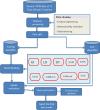Employing machine learning models to predict pregnancy termination among adolescent and young women aged 15-24 years in East Africa
- PMID: 39627430
- PMCID: PMC11615036
- DOI: 10.1038/s41598-024-81197-1
Employing machine learning models to predict pregnancy termination among adolescent and young women aged 15-24 years in East Africa
Abstract
Pregnancy termination is still a sensitive and continuing public health issue due to several political, economic, religious, and social concerns. This study assesses the applications of machine learning models in the prediction of pregnancy termination using data from eleven national datasets in East Africa. Nine machine learning models, namely: Random Forests (RF), Decision Tree, Logistic Regression, Support Vector Machine, eXtreme Gradient Boosting (XGB), AdaBoost, CatBoost, K-nearest neighbor, and feedforward neural network models were used to predict pregnancy termination, with six evaluation criteria utilized to compare their performance. The pooled prevalence of pregnancy termination in East Africa was found to be 4.56%. All machine learning models had an accuracy of at least 71.8% on average. The RF model provided accuracy, specificity, precision, and AUC of 92.9%, 0.87, 0.91, and 0.93, respectively. The most important variables for predicting pregnancy termination were marital status, age, parity, country of residence, age at first sexual activity, exposure to mass media, and educational attainment. These findings underscore the need for a tailored approach that considers socioeconomic and regional disparities in designing policy initiatives aimed at reducing the rate of pregnancy terminations among younger women in the region.
Keywords: Abortion; Artificial intelligence; Pregnancy termination; Women.
© 2024. The Author(s).
Conflict of interest statement
Declarations. Competing interests: The authors declare no competing interests. Ethics approval and consent to participate: Since this study was done using a secondary data source, participants’ consent is not applicable. However, a permission letter and approval were obtained from DHS which allows us to use the data.
Figures









Similar articles
-
Explainable artificial intelligence models for predicting pregnancy termination among reproductive-aged women in six east African countries: machine learning approach.BMC Pregnancy Childbirth. 2024 Sep 16;24(1):600. doi: 10.1186/s12884-024-06773-9. BMC Pregnancy Childbirth. 2024. PMID: 39285277 Free PMC article.
-
Exploring machine learning algorithms to predict not using modern family planning methods among reproductive age women in East Africa.BMC Health Serv Res. 2024 Dec 18;24(1):1595. doi: 10.1186/s12913-024-11932-x. BMC Health Serv Res. 2024. PMID: 39696425 Free PMC article.
-
Exploring machine learning algorithms to predict short birth intervals and identify its determinants among reproductive-age women in East Africa.BMC Pregnancy Childbirth. 2025 May 9;25(1):551. doi: 10.1186/s12884-025-07668-z. BMC Pregnancy Childbirth. 2025. PMID: 40346482 Free PMC article.
-
Artificial intelligence in clinical care amidst COVID-19 pandemic: A systematic review.Comput Struct Biotechnol J. 2021;19:2833-2850. doi: 10.1016/j.csbj.2021.05.010. Epub 2021 May 7. Comput Struct Biotechnol J. 2021. PMID: 34025952 Free PMC article. Review.
-
Machine Learning for Predicting Postoperative Atrial Fibrillation After Cardiac Surgery: A Scoping Review of Current Literature.Am J Cardiol. 2023 Dec 15;209:66-75. doi: 10.1016/j.amjcard.2023.09.079. Epub 2023 Oct 21. Am J Cardiol. 2023. PMID: 37871512
Cited by
-
Artificial Intelligence and Machine Learning: An Updated Systematic Review of Their Role in Obstetrics and Midwifery.Cureus. 2025 Mar 11;17(3):e80394. doi: 10.7759/cureus.80394. eCollection 2025 Mar. Cureus. 2025. PMID: 40070886 Free PMC article. Review.
References
-
- Harvard Health Publishing. Abortion (Termination Of Pregnancy): what is it? https://www.health.harvard.edu/medical-tests-and-procedures/abortion-ter... (2019).
-
- Clark Alves, S. M. October, Jenkins, Amanda Rapp. Early Pregnancy Loss (Spontaneous Abortion), 12 (StatPearls Publishing, 2023). - PubMed
-
- Diedrich, J. & Steinauer, J. Complications of surgical abortion. Clin. Obstet. Gynecol. 52, 205–212 (2009). 10.1097/GRF.0b013e3181a2b756. - PubMed
-
- Grimes, D. A. et al. Unsafe abortion: the preventable pandemic. Lancet368, 1908–1919. 10.1016/S0140-6736(06)69481-6 (2006). - PubMed
-
- United Nations Population Fund. Seeing the unseen: The case for action in the neglected crisis of unintended pregnancy. https://www.unfpa.org/swp2022 (2022).
MeSH terms
LinkOut - more resources
Full Text Sources
Medical

